Galeria de retlaw snellac
the world part 1
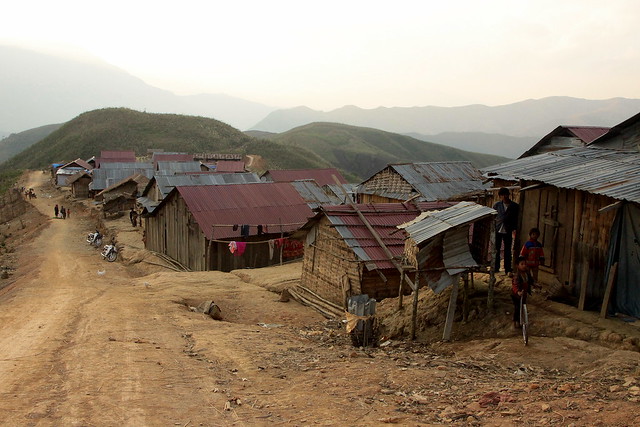
vietnam - ethnic minorities
Nampi, situated to the West of Muong Te, is a La Hu tribal village.
The La Hu live in villages built on mountain slopes. These houses are level with the ground and divided by bamboo partitions. The altar for the ancestors and the kitchen are always placed at the bay of the house, which is used for the family sleeping quarters. The right of inheritance is only reserved for sons. Young men and women are free to choose their partners. After the wedding, the groom has to live with his wife's family for several years, but then takes his wife to his family house.
La Hu women usually give birth in their bedroom. Three days later, the baby is given its name. If an unexpected guest comes during this time, he or she is given the honour of naming the newborn. The worship of the ancestors is reserved for the dead parents. Every year the La Hu hold ceremonies to worship the spirits of the earth and to pray for peace. They conjure up the souls of the corn and the rice spirits after the sowing and harvesting duties have been completed.
La Hu language belongs to the Tibeto-Burman Group. There are a dozen "khen" (pan-pipe) dances in La Hu culture. The songs are sung in the Ha Nhi language, but the La Hu have kept their own rhythms. The La Hu have a rich heritage of ancient tales, and they even maintain their own calendar in which the days are defined corresponding to twelve animals, including the tiger, rabbit, dragon, mouse, sheep, monkey, rooster, dog, pig, squirrel, snake and buffalo.
Women wear trousers and a long-lap shirt that falls to their ankles. They also wear a short vest
during festive days. The collar, chest stripes, and sleeves are either embroidered or sewn with colourful pieces of cloth, silver, tin coins, or red fringes.
The La Hu live on slash-and-burn cultivation and hunting. La Hu men are very skilled at blacksmithing and making rattan chairs, trays, mats.
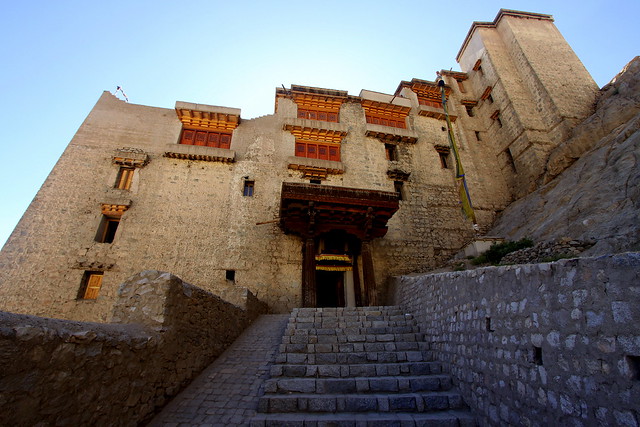
india - ladakh
Leh Fort.
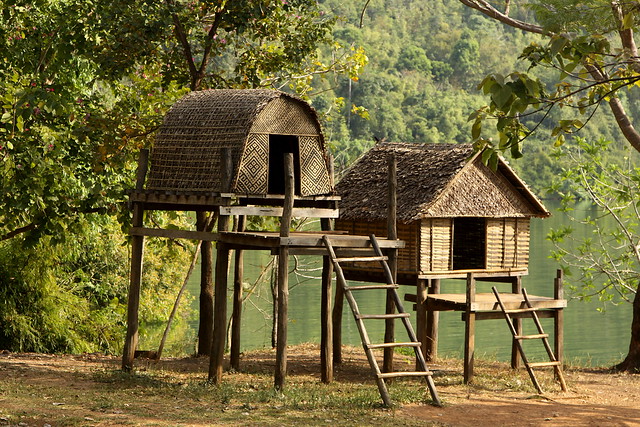
cambodia
Groom houses at Yeak Lom lake (Ratanakiri).
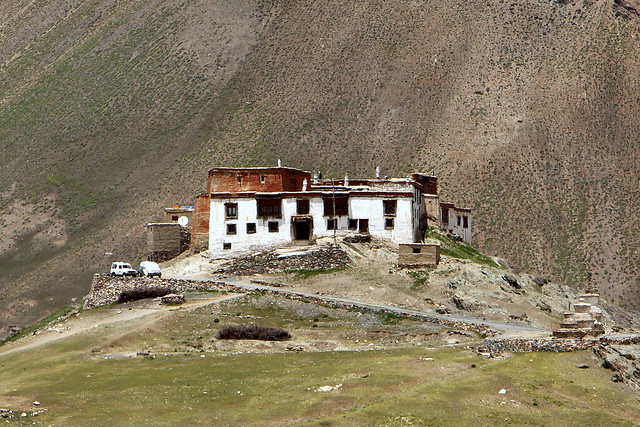
india - zanskar
Rangdum Monastery.
Rangdum Monastery is a Tibetan Buddhist monastery belonging to the Gelugpa sect, dramatically situated on top of a steep sugarloaf hill at an altitude of 3,657 m at the head of the Suru Valley, in Ladakh. it is next to the tiny village of Julidok, and about 25 km from the 4,400 m ) Pensi La (pass) which leads into Zanskar.
According to an inscription the monastery was built by Gelek Yashy Takpa during the reign of King Tsewang Mangyul of Ladakh about 200 years ago. Although it is physically in Ladakh, it is culturally part of Zanskar. Because one cannot count on crops being harvested due to the brief summer, both the village and the monastery depend on supplies, other than locally produced dairy, brought up the largely barren Suru Valley, or over the 4,400 metre (14,436 ft) Pensi La pass from Zanskar. The monastery has about 30 monks.
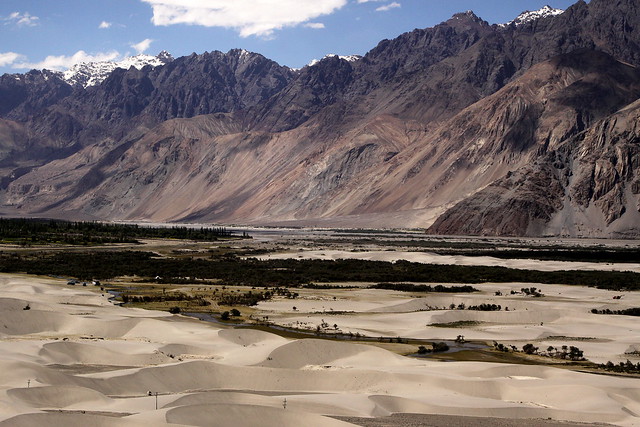
india - ladakh
Dunes in the Nubra Valley.
Nubra Valley is about 150 km north of Leh, the capital town of Ladakh, India. Local scholars say that its original name was Ldumra (the valley of flowers). The Shyok River meets the Nubra or Siachan River to form a large valley that separates the Ladakh and the Karakoram Ranges. The average altitude of the valley is about 10,000 ft. above the sea level. The common way to access this valley is to travel over the Khardung La from Leh.

the silk road
Terracotta Warriors and Horses.
The Terracotta Warriors and Horses are the most significant archeological excavations of the 20th century. Work is ongoing at this site, which is around 1.5 kilometers east of Emperor Qin Shi Huang's Mausoleum, Lintong County, Shaanxi province. It is a sight not to be missed by any visitor to China. Upon ascending the throne at the age of 13 (in 246 BC), Qin Shi Huang, later the first Emperor of all China, had work begun on his mausoleum. It took 11 years to finish. It is speculated that many buried treasures and sacrificial objects had accompanied the emperor in his after life. A group of peasants uncovered some pottery while digging for a well nearby the royal tomb in 1974. It caught the attention of archeologists immediately. They came to Xian in droves to study and to extend the digs. They had established beyond doubt that these artifacts were associated with the Qin Dynasty (211 --206 BC).
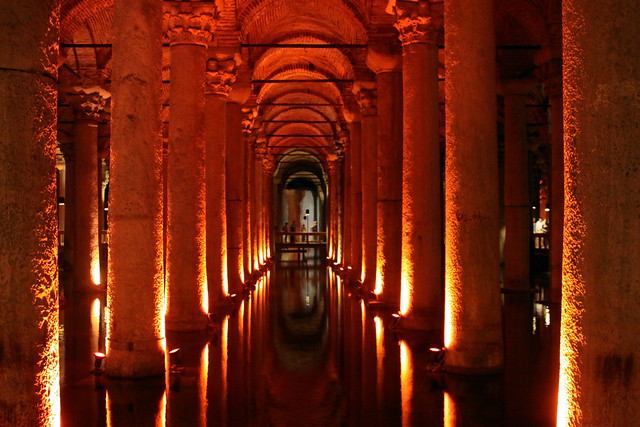
istanbul - turkey
Basilica Cistern (Istanbul).
The Basilica Cistern, also known as the "Sunken Palace" or "Yerebatan sarayi" in turkish, was constructed by Justinian in 532 to supply water to the Byzantine Palace primarily. Underground waterway was used as a reservoir for water storage for the Great Palace and other buildings. It is 132 m length, by 65m wide. There are 336 columns in the cistern. Most of the column capitals are either in Corinthian or Doric Style. Walk to the back of the Cistern, and you will find one upside down Medusa head supporting one of the columns. Why it is upside down has been a question of much discussion, but the best guess is that the people who placed the stone believed that if the head was upside down, it would ward off evil spirits. Not far from the upside-down Medusa head is a second Medusa head, which is sideways. Why one head is upside down and the other is sideways only deepens the question about their orientation. Perhaps the builders felt that to place two heads in the same orientation would empower the evil forces living in the snakes on Medusa's head. Also, their presence in the Cistern in the first place is interesting. Perhaps, since they were underwater for most of the ages, the evil forces remained safely submerged. Today it has been completely renovated. Water still drips melancholically through the ceiling, and the brick-domed ceiling echoes classical music.
See also:
www.flickriver.com/photos/waltercallens/random/
www.flickr.com/photos/waltercallens/favorites/
english.cohga.net/flickr/user/74089637@N00_1.html

the silk road
Bukhara is one of the most ancient cities of Uzbekistan. Bukhara city is supposed to be founded in the 13th century BC. The name of Bukhara originates from the word "vihara" which means "monastery" in Sanskrit. The city was once a large commercial center of the Great Silk Road; it was also a center of learning renowned throughout the Islamic world.
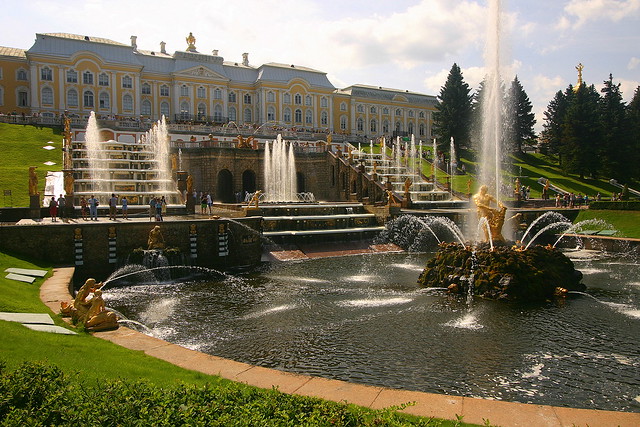
russia - st petersburg
Peterhof (Petrodvorets).
One of St. Petersburg's most famous and popular visitor attractions, the palace and park at Peterhof (also known as Petrodvorets) are often referred to as "the Russian
Versailles", although many visitors conclude that the comparison does a disservice to the grandeur and scope of this majestic estate.
Versailles was, however, the inspiration for Peter the Great's desire to build an imperial palace in the suburbs of his new city and, after an aborted attempt at Strelna, Peterhof - which means "Peter's Court" in German - became the site for the Tsar's Monplaisir Palace, and then of the original Grand Palace. The estate was equally popular with Peter's granddaughter, Empress Elizabeth, who ordered the expansion of the Grand Palace and greatly extended the park and the famous system of fountains, including the truly spectacular Grand Cascade. Improvements to the park continued throughout the 18th and 19th centuries. Catherine the Great, after leaving her own mark on the park, moved the court to Pushkin, but Peterhof once again became the official Imperial Residence in the reign of Nicholas I, who ordered the building of the modest Cottage Palace in 1826. Like almost all St. Petersburg's suburban estates, Peterhof was ravaged by German troops during the Second World War. It was, however, one of the first to be resurrected and, thanks to the work of military engineers and over 1,000 volunteers, most of the estate's major structures had been fully restored by 1947. The name was also de-Germanicized after the war, becoming Petrodvorets, the name under which the surrounding town is still known. The palace and park are once again known as Peterhof.

russia - st petersburg
Peterhof (Petrodvorets).
One of St. Petersburg's most famous and popular visitor attractions, the palace and park at Peterhof (also known as Petrodvorets) are often referred to as "the Russian
Versailles", although many visitors conclude that the comparison does a disservice to the grandeur and scope of this majestic estate.
Versailles was, however, the inspiration for Peter the Great's desire to build an imperial palace in the suburbs of his new city and, after an aborted attempt at Strelna, Peterhof - which means "Peter's Court" in German - became the site for the Tsar's Monplaisir Palace, and then of the original Grand Palace. The estate was equally popular with Peter's granddaughter, Empress Elizabeth, who ordered the expansion of the Grand Palace and greatly extended the park and the famous system of fountains, including the truly spectacular Grand Cascade. Improvements to the park continued throughout the 18th and 19th centuries. Catherine the Great, after leaving her own mark on the park, moved the court to Pushkin, but Peterhof once again became the official Imperial Residence in the reign of Nicholas I, who ordered the building of the modest Cottage Palace in 1826. Like almost all St. Petersburg's suburban estates, Peterhof was ravaged by German troops during the Second World War. It was, however, one of the first to be resurrected and, thanks to the work of military engineers and over 1,000 volunteers, most of the estate's major structures had been fully restored by 1947. The name was also de-Germanicized after the war, becoming Petrodvorets, the name under which the surrounding town is still known. The palace and park are once again known as Peterhof.
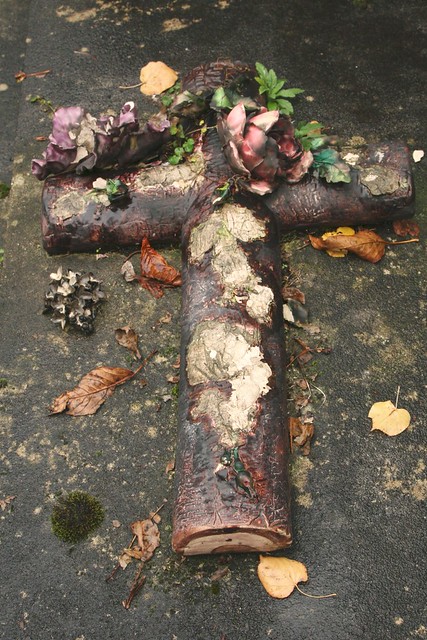
paris
Cimetière Montparnasse.
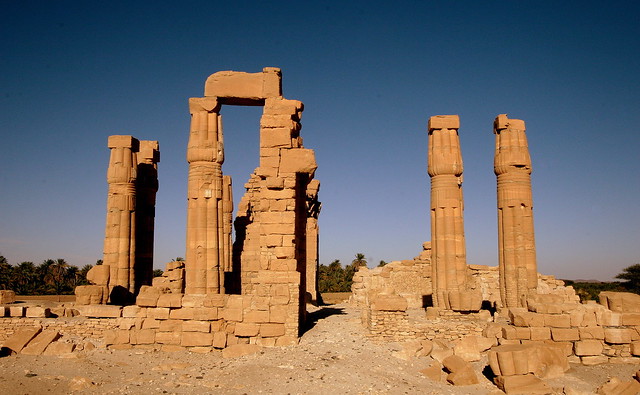
sudan - the black pharaohs
Soleb.
Ancient Egyptian temple site in Kush, on the west bank of the Nile, right south of the 3rd cataract in modern Sudan.
The temple here was built in the 14th century BCE by the command of Amenophis III and dedicated to Amon-Re of Karnak and Nebmaatre, which was both a deified version of the king himself and a local variant of Khonsu.
Nebmaatre was represented as a moon-god with the horns of Amon. This temple is the best preserved Egyptian-built temple in Sudan.
The temple was located close to the river, allowing a processional way from a quay to the main halls.
It was built with two pylons, a hypostyle hall, a courtyard and of course a sanctuary, resembling much the Temple of Luxor. It was altogether 130 metre long, and had columns carved as papyrus.
The temple here at Soleb played a central role in some the Egyptian myths, like where the eye of Horus was lost in a battle with Seth in Nubia. After this, the eye was supposed to have taken on the appearence of a lioness.
Two granite lions are among the most famous elements from the temple, but now in British Museum.
Within the temple complex there were was the arena to celebrate the Heb-Sed festival.
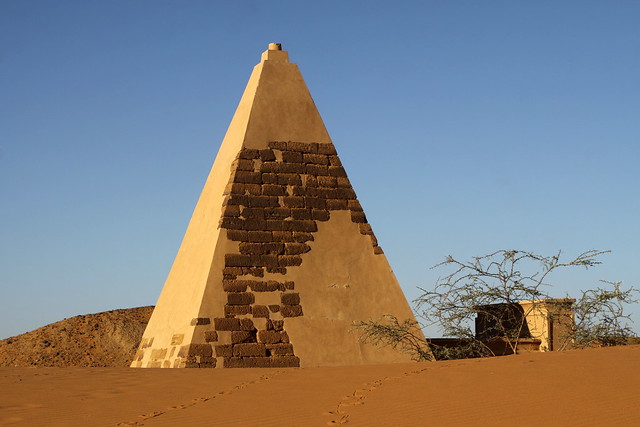
sudan - the black pharaohs
The Meroe Pyramids.
The Meroe Pyramids are located in the North-East of Sudan near the banks of the Nile in the area commonly known as Nubia. There are close to two hundred pyramids in a relatively small area, the ancient burial site of the Merotic Kingdom (sometimes known as the Kingdom of Kush). The Pyramids are smaller than their Egyptian cousins but equally impressive due to their number. The first of the Meroe Pyramids were built about 800 years after the last Egyptian pyramids were completed. The Meroe pyramids were constructed from large blocks of sandstone. They're angled more steeply than the Egyptian pyramids.
The Kush Kingdom flourished for 900 hundred years from around 800 B.C. to 280 A.D. and held power over a vast area covering much of the Nile Delta and as far south as Khartoum. Meroe became very important as the Kingdom's center from around 300 B.C. to 280 A.D. Egyptian influence remained strong and Egyptian artisans were used to build the Meroe Pyramids to commemorate dead royalty. The dead were buried in chambers underneath the pyramids.
Excavations of the Pyramids started in mid 19th Century. Most notoriously, an Italian explorer, Giuseppe Ferlini (1800-1870), smashed the tops off 40 pyramids in a quest to find treasure. What was found was brought back to British and German museums along with samples of Meroitic writing and reliefs depicting historical events. Through the years, the pyramids have been plundered of all their wealth and left to the elements. But many of the pyramids still stand and their architectural elegance is worth a trip. Some of the pyramids have been reconstructed so you get a good idea of what they must have looked like.
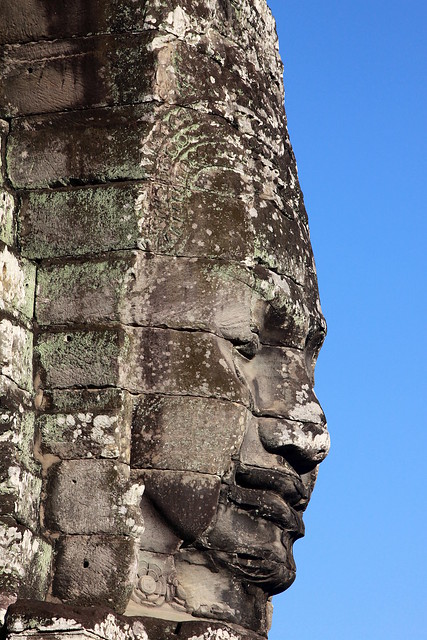
cambodia

russia - moscow
St. Basil's Cathedral (Moscow, Russia).
The famous St. Basil's Cathedral was commissioned by Ivan the Terrible and built on the edge of Red Square between 1555 and 1561. Legend has it that on completion of the church the Tsar ordered the architect, Postnik Yakovlev, to be blinded to prevent him from ever creating anything to rival its beauty again. The cathedral was built to commemorate Ivan the Terrible's successful military campaign against the Tartar Mongols in 1552 in the besieged city of Kazan. Victory came on the feast day of the Intercession of the Virgin, so the Tsar chose to name his new church the Cathedral of the Intercession of the Virgin on the Moat, after the moat that ran beside the Kremlin. The church was given the nickname "St. Basil's" after the "holy fool" Basil the Blessed (1468-1552), who was hugely popular at that time with the Muscovites masses and even with Ivan the Terrible himself. St. Basil's was built on the site of the earlier Trinity Cathedral, which at one point gave its name to the neighboring square. St. Basil's is a delightful array of swirling colors and redbrick towers. Its design comprises nine individual chapels, each topped with a unique onion dome and each commemorating a victorious assault on the city of Kazan. In 1588 the ninth chapel was erected to house the tomb of the church's namesake, Basil the Blessed. The church's design is based on deep religious symbolism and was meant to be an architectural representation of the New Jerusalem - the Heavenly Kingdom described in the Book of Revelation of St. John the Divine. The eight onion dome-topped towers are positioned around a central, ninth spire, forming an eight-point star. The number eight carries great religious significance; it denotes the day of Christ's Resurrection (the eighth day by the ancient Jewish calendar) and the promised Heavenly Kingdom - the kingdom of the eighth century, which will begin after the second coming of Christ. The eight-point star itself symbolizes the Christian Church as a guiding light to mankind, showing us the way to the Heavenly Jerusalem and it represents the Virgin Mary, depicted in Orthodox iconography with a veil decorated with three eight-pointed stars. The cathedral's star-like plan carries yet more meaning - the star consisting of two superimposed squares, which represent the stability of faith, the four corners of the earth, the four Evangelists and the four equal-sided walls of the Heavenly City. The extravagant and brightly colored domes of the cathedral's exterior mask a much more modestly decorated and somewhat less spectacular interior. Small dimly lit chapels and maze-like corridors fill the inside of the church and the walls are covered with delicate floral designs in subdued pastel colors dating from the 17th century. Visitors can climb up a narrow, wooden spiral staircase, set in one of the walls and discovered only in the 1970s during restoration work, and marvel at the Chapel of the Intercession's priceless iconostasis, dating back to the 16th century. There was so little room inside the church to accommodate worshippers, that on special feast days services were held outside on Red Square where the clergy communicated their sermons to the milling masses from Lobnoye Mesto, using St. Basil's as an outdoor altar. The church has narrowly escaped destruction a number of times during the city's tumultuous history. Legend has it that Napoleon was so impressed with St. Basil's that he wanted to take it back to Paris with him, but lacking to the technology to do so, ordered instead that it be destroyed with the French retreat from the city. The French set up kegs of gunpowder and lit their fuses, but a sudden, miraculous shower helped to extinguish the fuses and prevent the explosion. Early in this century the cathedral almost fell prey to the atheist principles of the Bolshevik regime. In 1918 the communist authorities shot the church's senior priest, Ioann Vostorgov, confiscated its property, melted down its bells and closed the cathedral down. In the 1930s Lazar Kaganovich, a close colleague of Stalin and director of the Red Square reconstruction plan, suggested that St. Basil's be knocked down to create space and ease the movement of public parades and vehicle movement on the square. Thankfully Stalin rejected his proposal as he did a second plan to destroy the cathedral. This time the courage of the architect and devotee of Russian culture, P. Baranovsky, saved the church. When ordered to prepare the cathedral for destruction he refused and threatened to cut his own throat on the steps of the church, then sent a bluntly worded telegram to the leader of the party himself relating the above. For some reason Stalin cancelled the decision to knock the church down and for his efforts Baranovsky was rewarded with five years in jail. An extensive program of renovation is still being carries out on both the exterior and interior of the church, but will not spoil that essential visit to St. Basil's Cathedral, Moscow's moat famous and arguably most beautiful ecclesiastical building. In the small garden outside St. Basil's stands an impressive bronze Statue to Minin and Pozharsky, who rallied Russia's volunteer army during the Time of Troubles and drove out the invading Polish forces. They were an interesting duo - Dmitry Pozharsky was a prince, while Kuzma Minin was a butcher from Nizhny Novgorod. The statue was designed by the artist I. Martos and erected in 1818 as the city's first monumental sculpture. It originally stood in the center of Red Square in front of what is now the GUM Department Store, with Minin symbolically indicating to Pozharsky that the Poles were occupying the Kremlin and calling for its liberation. The Soviet authorities felt that the statue had become an obstacle during parades and after the construction of the Lenin Mausoleum Red Square, its position was considered rather ambiguous and was eventually moved to the garden in front of St. Basil's in 1936.
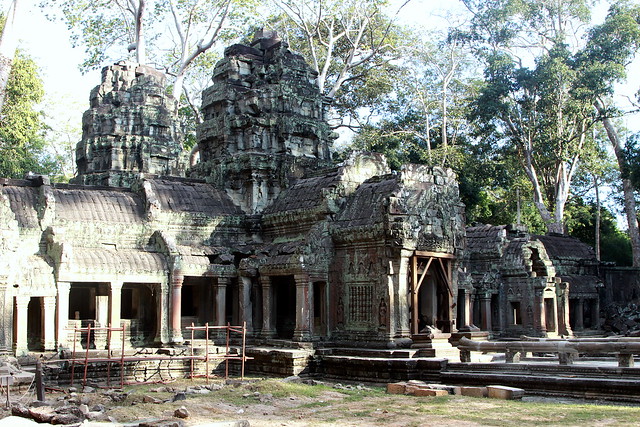
cambodia
Ta Prohm - Treasures of Angkor.
Unlike most of the temples of Angkor, Ta Prohm has been largely left to the clutches of the living jungle. With its dynamic interaction between nature and man-made art, this atmospheric temple is a favorite for many - who can't help but feel a little like Indiana Jones or Lara Croft (which was filmed here) as they pick through the rubble.
Construction on Ta Prohm began in 1186 AD. Originally known as Rajavihara (Monastery of the King), Ta Prohm was a Buddhist temple dedicated to the mother
of King Jayavarman VII.
A rare inscription at Ta Prohm provides statistics on the temple's workers. Allowing for some exaggeration to honor the king, the inscription's report of around 80,000 workers, including 2700 officials and 615 dancers, is still astounding.
Sadly, Ta Prohm was looted quite heavily in recent years due to its relative isolation, and many of its ancient stone reliquaries have been lost.
Great trees tower above Ta Prohm, their leaves filtering the sunlight, providing welcome shade and casting a greenish light over the otherwordly site. Delicately carved reliefs on the walls sprout lichen, moss and creeping plants. Some as wide as an oak tree, the vines at Ta Prohm cleave massive stones in two and spill over the top of temple ramparts. The effect is striking, especially at the strangulating root formation on the inside of the easternmost gopura (entrance pavilion). Another popular site is the "Tomb Raider tree" in the central sanctuary, where Angelina Jolie picked a jasmine flower and was sucked beneath the earth.
Ta Prohm is extensively ruined, but you can still explore numerous towers, close courtyards and narrow corridors, discovering hidden gems of stone reliefs beneath the encroaching foliage. Many of the corridors are impassible, thanks to the jumbled piles of carved stone blocks that clog their interiors. There are 39 towers at Ta Prohm, which are connected by numerous galleries.
The exterior wall of the compound is 1km by 600m (1/2 mile by 1,969 feet) and
the entrance gates have the classic Jayavarman face.

sudan - the black pharaohs
The Temple of Mut at Jebel Barkal.
The Temple of Mut , carved partly into the rock base of Jebel Barkal, was built by the pharaoh Taharqa in the 680s BCE.
Mut, Hathor, Bes are all represented in this unique temple. All can be identified in some regard with the myth of the "Eye of Re." It is possible that the colossal Bes images and the sistrum-headed Hathor images were included to soothe the anger of the goddess in the story, since Bes is a god of dance and the sistra makes rhythmic music.
Further, the goddesses represented here have important maternal roles in the myth of the divine origin of the king. According to Timothy Kendall, the pinnacle of the gebel (rising prominently above the Temple of Mut) was seen by the Kushites as phallic and a symbol of Amun's regenerative power.
Thus, it is possible that this temple of Mut (mother) with its apotropaic symbolism (the line of Bes statues and the systra) could have been conceived of and constructed as a symbolic womb; a female counterpart to the pinnacle.
The temple could represent a birthing house or mythological passage of birth, playing a role in both royal birth rituals and coronation ceremonies (also a kind of rebirth). The king then may have come to the temple to perform ritual acts of rebirth.

the silk road
Samanids Mausoleum, Bukhara.
Of all the medieval buildings in Bukhara, the Samanids Mausoleum is of special interest. This world-famous architectural masterpiece was built at the close of the ninth century. The mausoleum was erected as a family crypt immediately after the death of Ismail Samani's father. Later, Ismail himself and his grandson Hasr were also buried in it. It is interesting to note that erecting crypts was against Islamic law at that time, for Islam forbade erecting any post-mortem monuments upon the tombs of Muslim believers. However, the prohibition was broken in the middle of the ninth century by one of the caliphs himself, for whom a special as-Suli-biya Mausoleum was built. Ismail merely followed his example.
The Samanids Mausoleum reveals the genius of a plain design. This is seen in its composition and the balanced design of its facades and interiors. It is composed of a semi-spherical dome resting on a cube. All of the facades are identical and marked with three-quarter domed columns on the corners. There is an upper armature and a central entrance with a visible horizontal dividing line. The core is characterized by regular kiln-dried bricks, forming horizontal, vertical, and diagonal patterns on the walls. There are also separate details in the shape of disks or rosettes. Analysis shows that all elements in the Mausoleum are based on squares and diagonals: the elements form geometrically digressive lines. The same unification is seen in the architectural forms and kiln-dried brickwork in the interiors. The architectural design of the Samoniy mausoleum is entirely unique. It owes much to pre-lslamic Soghdian architecture, which used four-arch domed compositions and diminished forms on the top of buildings, including disks and rosettes on decoration columns (as can also be seen in the section between the dome and the drum of the interior). Although this building is connected with pre-Islamic architecture, it also anticipates the emergence of a new architectural style with comparatively small dimensions; the Samoniy Mausoleum is full of magnificence and feeling of moving from this world to the world that lasts forever.
Bukhara is one of the most ancient cities of Uzbekistan. Bukhara city is supposed to be founded in the 13th century BC. The name of Bukhara originates from the word "vihara" which means "monastery" in Sanskrit. The city was once a large commercial center of the Great Silk Road; it was also a center of learning renowned throughout the Islamic world.
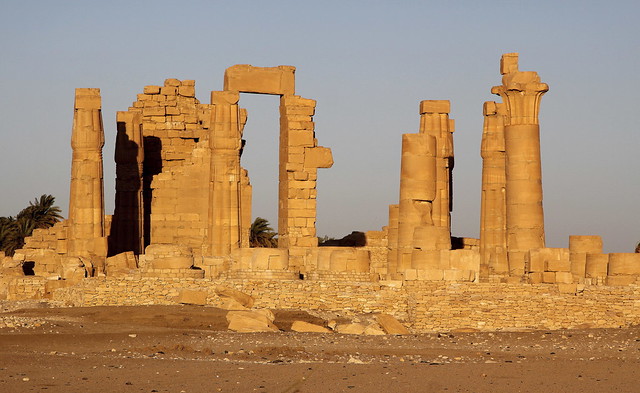
sudan - the black pharaohs
Soleb.
Ancient Egyptian temple site in Kush, on the west bank of the Nile, right south of the 3rd cataract in modern Sudan.
The temple here was built in the 14th century BCE by the command of Amenophis III and dedicated to Amon-Re of Karnak and Nebmaatre, which was both a deified version of the king himself and a local variant of Khonsu.
Nebmaatre was represented as a moon-god with the horns of Amon. This temple is the best preserved Egyptian-built temple in Sudan.
The temple was located close to the river, allowing a processional way from a quay to the main halls.
It was built with two pylons, a hypostyle hall, a courtyard and of course a sanctuary, resembling much the Temple of Luxor. It was altogether 130 metre long, and had columns carved as papyrus.
The temple here at Soleb played a central role in some the Egyptian myths, like where the eye of Horus was lost in a battle with Seth in Nubia. After this, the eye was supposed to have taken on the appearence of a lioness.
Two granite lions are among the most famous elements from the temple, but now in British Museum.
Within the temple complex there were was the arena to celebrate the Heb-Sed festival.

india - andhra pradesh
The Charminar is as much the signature of Hyderabad as the Taj Mahal is of Agra or the Eiffel Tower is of Paris. Mohammed Quli Qutb Shah, the founder of Hyderabad, built Charminar in 1591 at the centre of the original city layout. It was said to be built as a charm to ward off a deadly epidemic raging at that time. Four graceful minarets soar to a height of 48.7m. above the ground. Charminar has 45 prayer spaces and a mosque in it. Visitors can view the architectural splendour inside the Charminar. The monument is illuminated in the evenings and a pedestrianisation project around the monument is
under implementation.

india - andhra pradesh
The Charminar is as much the signature of Hyderabad as the Taj Mahal is of Agra or the Eiffel Tower is of Paris. Mohammed Quli Qutb Shah, the founder of Hyderabad, built Charminar in 1591 at the centre of the original city layout. It was said to be built as a charm to ward off a deadly epidemic raging at that time. Four graceful minarets soar to a height of 48.7m. above the ground. Charminar has 45 prayer spaces and a mosque in it. Visitors can view the architectural splendour inside the Charminar. The monument is illuminated in the evenings and a pedestrianisation project around the monument is
under implementation.
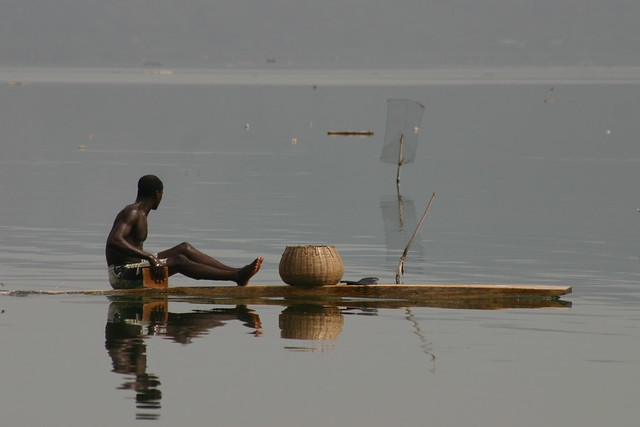
ghana
Fisherman on the lake Bosomtwe, the holy lake of the Ashanti people.
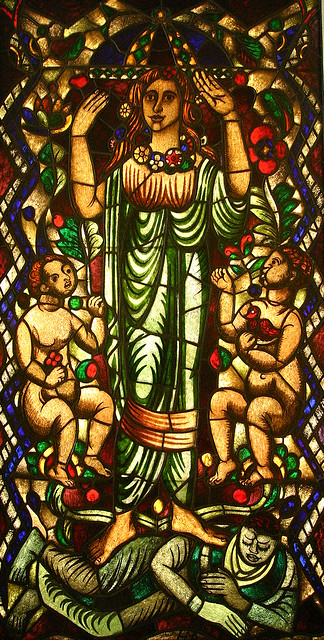
berlin
Stained-glass window of the St Matthäus church in Berlin.
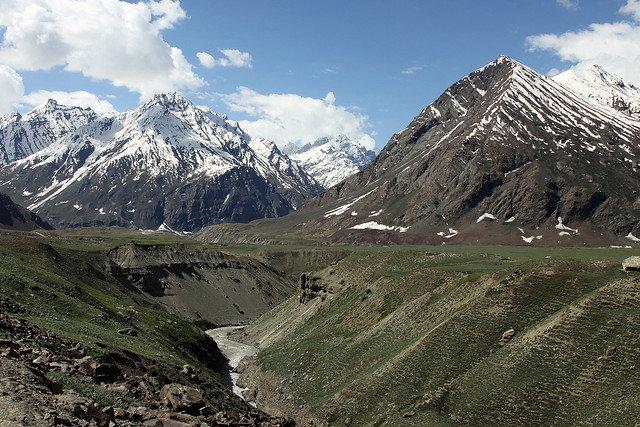
india - zanskar
Landscape in Zanskar.

the silk road
Bukhara is one of the most ancient cities of Uzbekistan. Bukhara city is supposed to be founded in the 13th century BC. The name of Bukhara originates from the word "vihara" which means "monastery" in Sanskrit. The city was once a large commercial center of the Great Silk Road; it was also a center of learning renowned throughout the Islamic world.
| The Ultimate Self Realization Course (tm) | | |
| Special New Release--Hear It Right Now!! | Special Announcements!
| See Sankarshan Prabhu's | |
| Get Krishna's Special Mercy by Rendering Devotional Service If you'd like to contribute something to help cover the expenses of Sankarshan Prabhu's European Lecture Series you can | On the order of his spiritual master, Srila Prabhupada, Sankarshan Prabhu has dedicated his life for the most urgent work of spreading Krishna consciousness all over the world. The more that Krishna consciousness spreads, the more that the suffering, scarcity, and hate on this planet will be replaced with bliss, abundance and love. This is a golden opportunity for us to do the highest good for all living beings and receive the special blessings of the Lord. Therefore we should, as much as possible, sacrifice our time, energy, and resources to assist Sankarshan Prabhu in his most important work. If you would like to help out to any extent, little or big, kindly inform Sankarshan Prabhu of your desire. | Meet If you would like to meet Sankarshan Prabhu or hear his lectures, you may contact us directly for an appointment or specific information on where and when his lectures will be held. | |
| Do You Have Questions or Need Guidance? | All inquiries are welcome. | Contact Information: Phone: 1-512-835-2121 or Email your questions |

 Sri Krishna Janmastami
Sri Krishna Janmastami Maha Kalash Abhisekha
Annual Patron Member Puja You are cordially invited to sponsor a Golden Kalash to bathe Sri Sri Radha Krishna, on the most auspicious day of
Sri Krishna Janmastami
(September 4, 2007)
This is a wonderful chance for you and your family to sponsor a beautiful bathing ceremony for Sri Sri Radha and Krishna. With your generous sponsorship, you will get to keep the sacred Kalash that the temple priest uses to bathe the Lord on your behalf. We will mail you your golden Kalash along with a wonderful assortment of prasadam sweets that will be offered to Sri Sri Radha Krishna on Janmastami. Your tax deductible contribution with help us to maintain and develop the worship of Lord Krishna.
Your golden Kalash is an amazingly beautiful transcendental work of art that your family will treasure for many generations. It will be shipped to you in a red velvet box as seen above:
There is a very limited supply. So if you would like to to sponsor a Kalash, do so right away before they are all taken: www.backtohome.com/Kalash
| ||
| Home | Thought for The Day | Audio | Videos | Photos | Itinerary | Meditations on Pure Bhakti | Offerings | Services | ||
|

Up

TABLA - FUENTES - FONTS
SOUV2
- SOUV2P.TTF - 57 KB
- SOUV2I.TTF - 59 KB
- SOUV2B.TTF - 56 KB
- SOUV2T.TTF - 56 KB
- bai_____.ttf - 46 KB
- babi____.ttf - 47 KB
- bab_____.ttf - 45 KB
- balaram_.ttf - 45 KB
- SCAGRG__.TTF - 73 KB
- SCAGI__.TTF - 71 KB
- SCAGB__.TTF - 68 KB
- inbenr11.ttf - 64 KB
- inbeno11.ttf - 12 KB
- inbeni11.ttf - 12 KB
- inbenb11.ttf - 66 KB
- indevr20.ttf - 53 KB
- Greek font: BibliaLS Normal
- Greek font: BibliaLS Bold
- Greek font: BibliaLS Bold Italic
- Greek font: BibliaLS Italic
- Hebrew font: Ezra SIL
- Hebrew font: Ezra SIL SR
Disculpen las Molestias

Up
Sankarshan Das Adhikari - ANUAL
Conceptos Hinduistas (1428)SC
Aa-Anc · Aga - Ahy · Ai - Akshay · Akshe - Amshum · Ana - Ancie · Ang - Asvayu · Ata - Az · Baa-Baz · Be-Bhak · Bhal-Bu · C · Daa-Daz · De · Dha-Dry · Du-Dy · E · F · Gaa-Gayu · Ge-Gy · Ha-He · Hi-Hy · I · J · K · Ka - Kam · Kan - Khatu · Ki - Ko · Kr - Ku · L · M · N · O · P · R · S · Saa-San · Sap-Shy · Si-Sy · Ta - Te · U · V · Ve-Vy · Y · Z
Conceptos Hinduistas (2919) SK
Aa-Ag · Ah-Am · Ana-Anc · And-Anu · Ap-Ar · As-Ax · Ay-Az · Baa-Baq · Bar-Baz · Be-Bhak · Bhal-Bhy · Bo-Bu · Bra · Brh-Bry · Bu-Bz · Caa-Caq · Car-Cay · Ce-Cha · Che-Chi · Cho-Chu · Ci-Cn · Co-Cy · Daa-Dan · Dar-Day · De · Dha- Dny · Do-Dy · Ea-Eo · Ep-Ez · Faa-Fy · Gaa-Gaq · Gar-Gaz · Ge-Gn · Go · Gra-Gy · Haa-Haq · Har-Haz · He-Hindk · Hindu-Histo · Ho-Hy · Ia-Iq · Ir- Is · It-Iy · Jaa- Jaq · Jar-Jay · Je-Jn · Jo-Jy · Kaa-Kaq · Kar-Kaz · Ke-Kh · Ko · Kr · Ku - Kz · Laa-Laq · Lar-Lay · Le-Ln · Lo-Ly · Maa-Mag · Mah · Mai-Maj · Mak-Maq · Mar-Maz · Mb-Mn · Mo-Mz · Naa-Naq · Nar-Naz · Nb-Nn · No-Nz · Oa-Oz · Paa-Paq · Par-Paz · Pe-Ph · Po-Py · Raa-Raq · Rar-Raz · Re-Rn · Ro-Ry · Saa-Sam · San-Sar · Sas-Sg · Sha-Shy · Sia-Sil · Sim-Sn · So - Sq · Sr - St · Su-Sz · Taa-Taq · Tar-Tay · Te-Tn · To-Ty · Ua-Uq · Ur-Us · Vaa-Vaq · Var-Vaz · Ve · Vi-Vn · Vo-Vy · Waa-Wi · Wo-Wy · Yaa-Yav · Ye-Yiy · Yo-Yu · Zaa-Zy







No hay comentarios:
Publicar un comentario